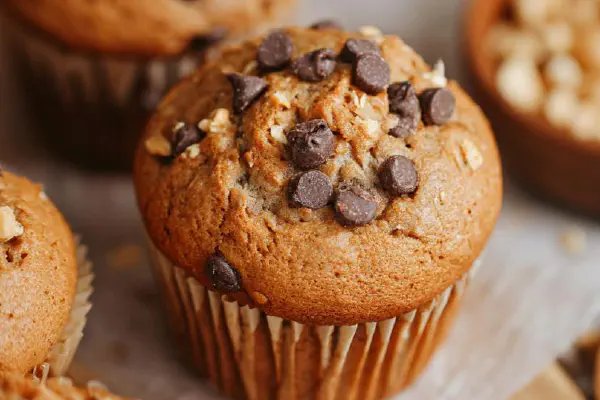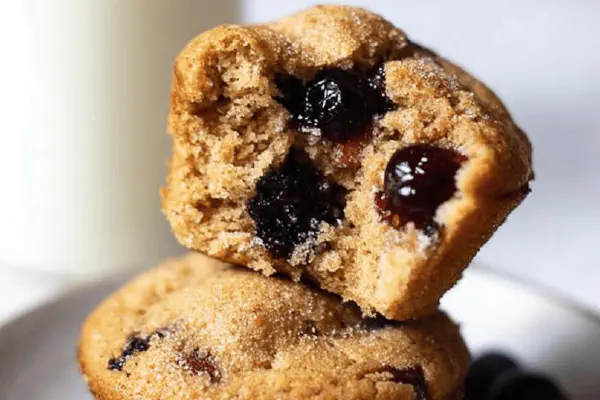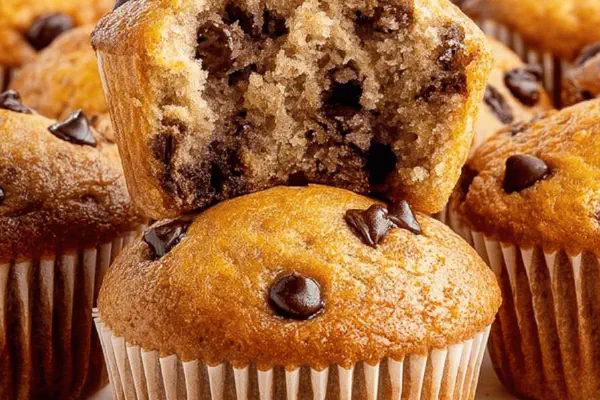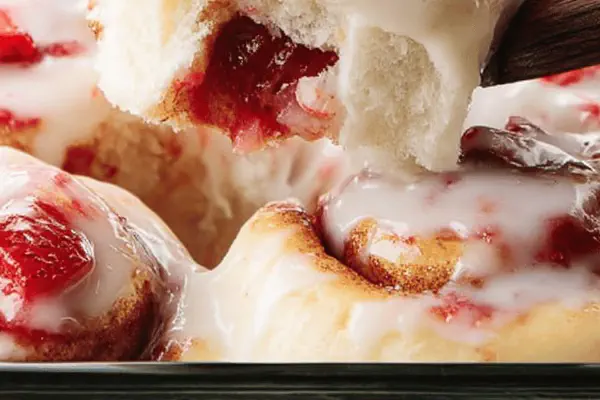Peanut Butter Chocolate Chip Muffins

By Emma
Certified Culinary Professional
Ingredients
- 1 cup all-purpose flour
- 1⁄4 cup oat flour
- 1 tsp baking powder
- 3⁄4 tsp baking soda
- 1⁄2 tsp salt
- 3⁄4 cup milk
- 1⁄3 cup peanut butter, preferably natural with some oil stirred in
- 1⁄4 cup packed brown sugar
- 1⁄4 cup granulated sugar
- 1⁄3 cup vegetable oil
- 2 large eggs
- 1 tsp vanilla extract
- 3⁄4 cup mini chocolate chips plus extra
- 2 Tbsp crushed roasted peanuts, unsalted
About the ingredients
Method
- Preheat oven to 425F. Line two 12-cup muffin tins with 6 liners each; place liners in every other cup to space them out. Helps tops rise taller.
- In a large bowl, sift together all-purpose flour, oat flour, baking powder, baking soda, and salt. Toss to combine evenly.
- In another bowl, whisk milk, peanut butter (stir oil back in for looser texture), brown and white sugars, vegetable oil, eggs, and vanilla extract until homogenized. Slightly lumpy is fine.
- Fold wet into dry carefully, just until no dry streaks remain; overmix and muffins stiffen. Gritty texture from peanut butter chunks is normal.
- Add mini chocolate chips; fold a couple of times to distribute. Don’t break chips; they bleed color.
- Cover bowl with plastic wrap; rest batter 30-60 minutes at room temp. Gluten relaxes, batter thickens, better muffin domes result. Skip rest—muffins stay flat.
- Scoop batter with a 2 Tbsp cookie scoop into prepared liners, filling about 3⁄4 full. Do not overfill or batter spills over edges.
- Sprinkle extra mini chocolate chips and crushed peanuts atop each. Adds texture and that toasty aroma.
- Bake at 425F for 5-6 minutes then lower heat to 345-350F. Bake 12-15 more min. Muffins should be golden with slightly puffed tops. A toothpick poked near center should come out mostly clean with a few moist crumbs.
- Listen for the faint crackle on top; smell nutty peanut aroma intensify. Avoid opening oven multiple times—oven spring happens fast and lost heat ruins rise.
- Cool muffins in pans 8-10 minutes to set interiors. Then transfer to wire rack to prevent soggy bottoms. Serve warm to enjoy melty peanut butter pockets and soft crumb.
- Leftover muffins reheat in microwave for 10-15 seconds. If batter too stiff after resting, loosen with splash more milk next try.
Cooking tips
Chef's notes
- 💡 Batter resting crucial. Skip this rest, muffins stay flat and dense. Resting relaxes gluten, thickens batter, domes rise taller. Covered bowl, 30-60 minutes at room temp. Watch batter texture. Too thick? Add splash milk next try. Rest varies by flour blend and peanut butter moisture content.
- 💡 Liners in every other cup for more room. Muffins climb higher; not cramped. Crowded tins lead to squashed tops, uneven bake. Also helps heat circulate. Double liners is waste. Space them out like this always. Helps domes form and prevent spillover during rise.
- 💡 High oven temp start is jumpstart. 425F for 5-6 min sets muffin structure fast. Then reduce to 345-350F to finish baking without dark crust. Crust color changes signal doneness; look for golden matte finish, slight puff on top. Toothpick test best but near center only, avoid liner holes.
- 💡 Folding is delicate. Wet into dry, just fold gently until no dry streaks. Don’t stir or overmix. Peanut butter chunks create gritty texture; normal. Overmix = tough muffins. Chocolate chips fold in carefully; break chips and they bleed color into batter, mess with muffin look and texture.
- 💡 Peanut butter type shifts texture. Natural with oil stirred in yields moist, chunkier crumb. Creamy peanut butter = smooth but less complex crumb textures. Use almond or cashew butter if no peanuts but reduce added oil, batter consistency changes. Egg structure and oil balance critical with swaps.
Common questions
Why rest muffin batter?
Gluten needs to relax. Batter thickens too. No rest means flat, denser muffins. Rest 30-60 minutes, covered, room temp. Shorter rest possible but less dome. Some skip rest but lose rise and texture.
Can I swap peanut butter?
Almond or cashew butter works. Oil content differs. Reduce extra oil if creamy nut butter. Texture changes; nut flavor shifts. Watch batter thickness. Also allergens if skipping peanuts. Adjust sugar if needed.
What causes dense muffins?
Usually overmixing. Stir too much and you activate gluten too much. Muffins stiffen, lose soft crumb. Also filling liners too full or skipping batter rest cause flatness. Oven temp too low at start can fail to jumpstart rise.
How to store leftovers?
Cool completely first. Wrap loosely or use container not airtight to avoid soggy crust. Refrigerate for longer storage, reheat briefly in microwave to revive softness. Freeze wrapped tight; thaw at room temp with short reheat. Avoid airtight for day storage, trap moisture.



